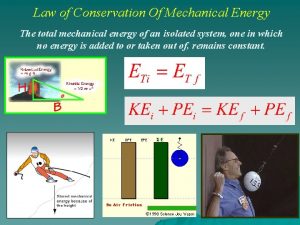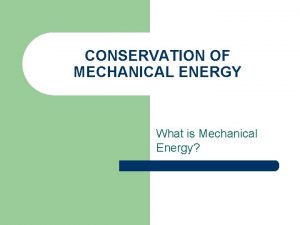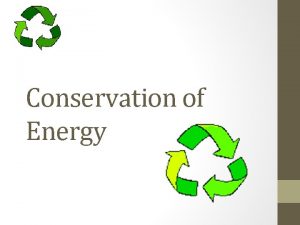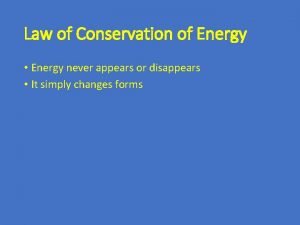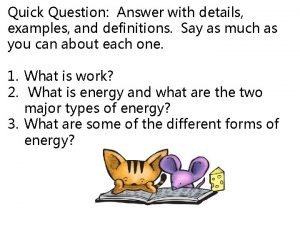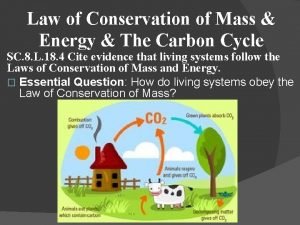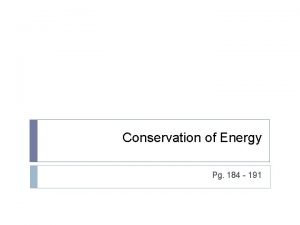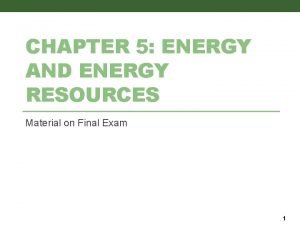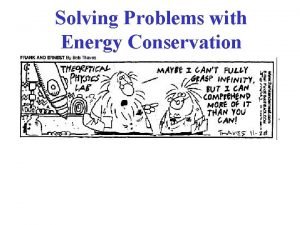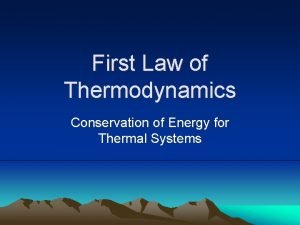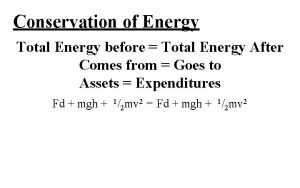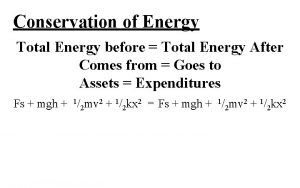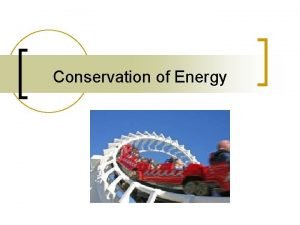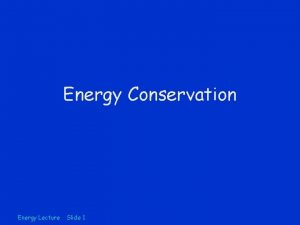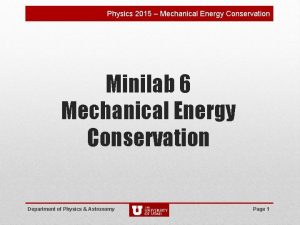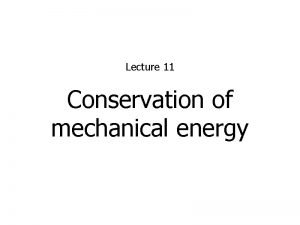Law of Conservation Of Mechanical Energy The total




























- Slides: 28

Law of Conservation Of Mechanical Energy The total mechanical energy of an isolated system, one in which no energy is added to or taken out of, remains constant.

Law of Conservation Of Mechanical Energy

Law of Conservation Of Mechanical Energy: The sum of the kinetic and potential energies.

Law of Conservation Of Mechanical Energy Why is the first hill the biggest?

Law of Conservation Of Mechanical Energy The loss in kinetic energy equals the gain in potential energy and vice versa

Law of Conservation Of Mechanical Energy Potential Energy transforms into kinetic energy and vice versa. Ex: Roller coasters, pendulums, slides, etc.

Law of Conservation Of Mechanical Energy Pendulum -Energy changes from potential to kinetic All Kinetic here

Law of Conservation Of Mechanical Energy PE Changing to KE

Law of Conservation Of Mechanical Energy Potential Energy to Kinetic Energy (Transformation of Energy)

Law of Conservation Of Mechanical Energy Friction takes Mechanical Energy out of the system

Law of Conservation Of Mechanical Energy Fred, a 100 kg skier starts from rest atop a 10 m hill, calculate: 1. His initial potential energy 2. His kinetic energy at point B 3. His speed at point B

Law of Conservation Of Mechanical Energy 1. 2. 3. When is the kinetic energy increasing? When is the potential energy increasing? When is the total energy increasing?

Law of Conservation Of Mechanical Energy m=75 kg v=o A B C Calculate the Kinetic energy and Gravitational Potential energy at the following points: 1) A 2) B 3) C

Law of Conservation Of Mechanical Energy Calculate: 1. The Kinetic and potential energies at points A, B, and C. 2. The total energy at each point. m = 200 kg v =5 m/s

Law of Conservation Of Mechanical Energy A. 5 kg pop-up toy has a spring constant of 30 N/m and is compressed 3 cm (. 03 m) from equilibrium. 1. How much elastic spring Potential energy does it have 2. The spring is released and the toy rises, how much potential energy will it have at its maximum height? 3. How high will it rise?

Law of Conservation Of Mechanical Energy BOW AND ARROW: 1. The arrow initially has Elastic spring potential energy. 2. When it it released it changes to kinetic energy 3. Therefore the initial PEs = KEf If the bow is stretched. 5 meters from Its equilibrium position, and the mass of the arrow is. 2 kg, find: Spring constant k =100 N/m 1. The initial elastic spring potential stored in the arrow 2. The final speed of the arrow as it leaves the bow.

Law of Conservation Of Mechanical Energy If non conservative forces are doing work

Law of Conservation Of Mechanical Energy Kinetic Energy transformed to Elastic Spring Potential Energy

Law of Conservation Of Mechanical Energy Conservative System Non Conservative System

Law of Conservation Of Mechanical Energy 1. 2. 3. 4. Real world: Mechanical energy is not conserved. Pendulum doesn’t swing forever, cars slow down Reason: Dissipative forces (friction, air drag) Energy is conserved, but not mechanical energy! Heat and Friction

Law of Conservation Of Mechanical Energy Formula for adding friction or air drag Ex: If a 2 kg ball is released from rest from the top of the incline and friction does 3 J of work as the object goes down the incline. 4 m 3 m 1. How much Kinetic energy will it have at the bottom of the incline? 2. What will be the speed of the ball at the bottom of the incline?

Law of Conservation Of Mechanical Energy

Law of Conservation Of Mechanical Energy If L=1 meter, calculate the speed ot the pendulum bob at the bottom

Law of Conservation Of Mechanical Energy Transformation The water behind the Hoover Dam has potential energy. As it falls it’s converted into kinetic energy. At the bottom it hits turbine blades that drive generators and is converted into electrical energy.

Law of Conservation Of Mechanical Energy 1. 2. 3. 4. 5. A 2 kg mass is placed on a frictionless track at point A and released from rest The gravitational potential energy of the system at point A is: (1) 80 J (2) 20 J (3) 8. 0 x 102 J (4) 7. 0 x 102 J Compared to the kinetic energy of the mass at point B, the kinetic energy of the mass at point E is: (1) ½ (2) 2 X (3)the same (4) 4 X As the mass travels along the track, the maximum height it will reach above point E will be closest to: (1) 10 m (2) 20 m (3) 30 m (4) 40 m If the mass were released from rest at point B, its speed at point C would be: (1) 0 m/s (2) 0. 50 m/s (3) 10 m/s (4) 14 m/s Compared to the total mechanical energy of the system at point A, the total mechanical energy point F is: (1) less (2) more (3) the same

Law of Conservation Of Mechanical Energy

Law of Conservation Of Mechanical Energy

Law of Conservation Of Mechanical Energy Fill out the remainder of the chart, based on the roller coaster in the previous slide, first find the mass. Height Speed P. E. K. E. Total (m) (m/s) (J) Energy (J) 2. 00 3. 920 J 1. 50 1. 00 0. 50 0. 00
 Formula kinetic energy
Formula kinetic energy Conservation of mechanical energy
Conservation of mechanical energy Conservation of mechanical energy examples
Conservation of mechanical energy examples Mechanical energy examples
Mechanical energy examples Examples of the conservation of energy
Examples of the conservation of energy Spring potential and kinetic energy
Spring potential and kinetic energy W=fd
W=fd Potential energy units
Potential energy units Gravitational potential energy store
Gravitational potential energy store The total mechanical energy of a swinging bungee jumper
The total mechanical energy of a swinging bungee jumper What is the total mechanical energy
What is the total mechanical energy Law of conservation of energy worksheets
Law of conservation of energy worksheets Energy conservation law
Energy conservation law Law of conservation of energy example
Law of conservation of energy example Grade 7 term 3 ns project
Grade 7 term 3 ns project The law of conservation of energy states that
The law of conservation of energy states that Potential vs kinetic energy
Potential vs kinetic energy Conservation of energy
Conservation of energy Conservation of energy
Conservation of energy The law of conservation of energy states that
The law of conservation of energy states that How to solve mechanical energy
How to solve mechanical energy First law of td
First law of td Chapter 7 energy conservation of energy
Chapter 7 energy conservation of energy How to convert mechanical energy to electrical energy
How to convert mechanical energy to electrical energy Examples of mechanical energy at home
Examples of mechanical energy at home How do electric motors work
How do electric motors work How to calculate useful energy output
How to calculate useful energy output Newton's first law and second law and third law
Newton's first law and second law and third law Si unit of newton's first law
Si unit of newton's first law

